|
|
| THE HISTORICAL STONES |
 |
| |
| Pinauda in 1928 gave this definition:
"The Milan Cathedral, one of the wonders of the modern world, is nothing but a mountain made of ossolano marble artistically carved".
In this area another factor has made this stone important both with regard to extracting and to the diffusion of the product: during Medieval stone materials, essentially marbles, could reach places like Milan and Pavia, where they were highly desirable to create ornaments. The transport was quite easy: by waterways. (Toce, Lake Maggiore, Ticino, Naviglio (Canal).
|
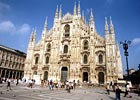 |
| The Milan Cathedral |
|

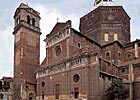 |
| the Cathedral of Pavia |
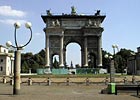 |
the Peace Arc
in Milan |
|
The Ossolano marbles, even if moderate in quantity compared to others materials, have had, even in the past, a great utilization, because of their intrinsic features and thanks to the good viability that has allowed them to reach easily cities like Milan and Pavia. Apart from the Candoglia pink marble, the varieties can be found:
- in the territory of Ornavasso, the Boden Ornavasso grey marble and the Rosa Valtoce (pink), geologically speaking similar to the Candoglia marble, but located on the west of the Ossola Valley.
- in Crevoladossola, the marble of Crevola. With this marble are made the stones used for the construction of the Cathedral of Pavia, during the XIV century, and for the colonnade and the statues for the Arco della Pace (Peace Arc) in Milan .
Using the Crevola marble they built an important sculpture for the United Nation Children's Found, entitled “L'uovo della pace (The Peace Egg)”.
|

Another material, very characteristic and mostly diffused in the low part of the valley, is known, commercially speaking, as beola or bevola. The second is the name that during the XV century was attributed to the town Beura, that features the higher number of quarries. "HVNC LAPIDEM BEVRA DEDIT", in 1513 they wrote on the cover in a burial that existed, a long time ago, in the cloister of the franciscan community in Domodossola. This burial cover was afterwards placed in a chapel in Pallanzeno. The time when the exportation of the products from these caves began, which are probably the most ancient in Ossola, dates back to the end of the XIII century, when the Naviglio Grande was made navigable up to Milan; even if it is not
unlikely that the Romans themselves had exported the stones from Beura, since the ancient roman road passed inside this town. Today they quarry many different types of stones, mostly on the basis of colour.
|
| The beolas is the most practical and right material for the local building trade (but not only), and this is efficiently demonstrated by every local administration in the valley.
Domodossola has a concrete example: all pedestrian walkways were built using beolas; the oldest buildings too are, totally, built with beolas. Beolas were used for walls, gardens, building balconies, terraces, shelves, doors and windows frame and even rooves.
|
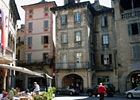 |
| Domodossola |
|


Granites are intrusive Permian magmatic rocks (280 Ma), they outcrop from the top of the Ossola Valley, close to the Lake Maggiore; the most marketed varieties are the Baveno pink granite, the Montorfano white granite and the Mergozzo green granite. They represent about 1/10 compared to all the serizzos and beolas but their homogranular texture and their excellent physical and mechanical features make them a valuable material both in the building and in the decorative field.
|
| Their use started in the sixteenth century (pink granite colonnade of the Milan Lazzaretto) and was developed in the seventeenth century, particularly for the columns of great palaces and religious buildings, having the possibility to carve huge blocks.
In the eighteenth and nineteenth century the Verbano granites were also used for plinths, steps, doorways and floorings.
There are manufactured articles and handiworks in all the Piedmont, but even in Rome where there is the Basilica di S. Paolo Fuori le Mura (St. Paul's Outside the Walls), made in white Montorfano granite.
In New York the Christopher Columbus Monument was made in pink granite - which has crossed the oceans too- just like the Bangkok Royal Palace.
|
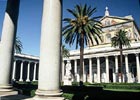 |
| Basilica di S.Paolo F.M. |
|
|




